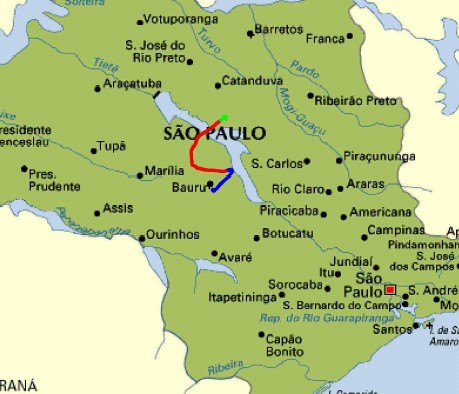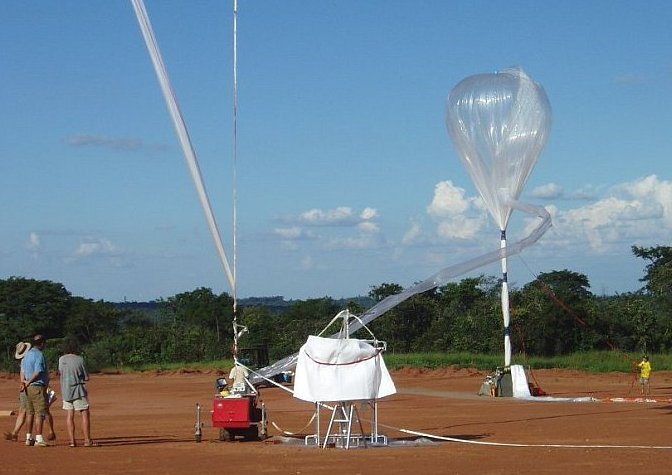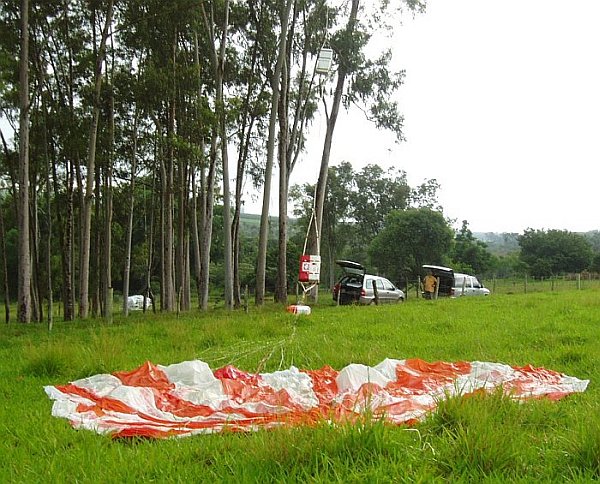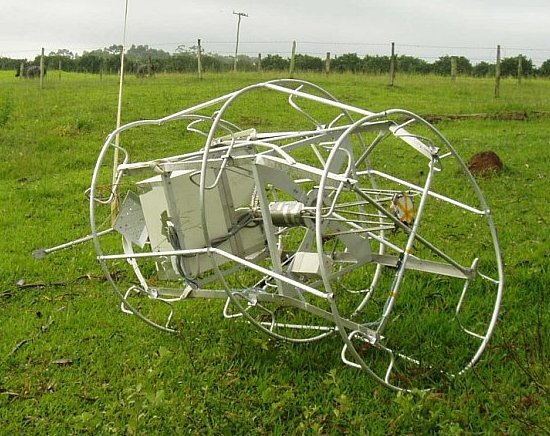Purpose of the flight and payload description
The SF series of multi-instrument balloon flights during HIBISCUS camapign were planned to be launched in late afternoon, and once reached float altitude left them to descend very slowly (0.5 meter per second or less) after their cooling at night for exploring the Tropical Tropopause Layer and the Upper Troposphere down to 12-14 km. The flight train was integrated by the following instruments:
DESCARTES stands for Détermination Et Séparation par Chromatographie lors de l'Analyse des Résultats des Traceurs Échantillonés dans la Stratosphère and was created for the measurement of long-lived trace gases (CFC-11, CFC-113, CCl4 and CH3CCl3) in the stratosphere by the University of Cambridge. The low weight of less than 20 kg and no need for telemetry make the instrument suitable for being launched on small balloons or fly as piggyback on larger balloons. The working principle is to let an amount of air pass through 16 sample tubes containing a Carboxen adsorbent. A valve allows only one tube at a time to be exposed to the air flow. Trace gases will then be trapped inside the sample tubes while the rest passes through. An on-board computer controls the sampling sequence, and also measures the flow of air, the pressure and temperature, the level of the batteries, and the state and position of the valve. After the flight, the data is downloaded from the computer, the sample sizes are determined and the sample box is connected to a gas chromatograph for quantification.
µLIDAR also known as MULID which is the first lightweight balloon-borne microlidar ever built. It was developed by CNR-ENEA to measure the depolarized signal backscattered by cloud particles. It's light source is a solid state laser of 1.5 µJoules of power that operates at a repetition rate of 1 kHz and at a wavelength of 532 nm. The receiver is composed by a Newtonian modified reflector telescope and the detectors are two photo-multipliers modules used to collect the backscattered light and to divide it according to its wavelength. The whole system (weighting 4 kg) is enclosed in an insulating polyurethane shield to reduce heat exchange with external environment and externally covered by a reflecting Mylar microfilm. The gondola final weight including batteries and balloon control systems is of 10 kg.
µDIRAC which stands for Determination In situ by Rapid Analytical Chromatography was designed by the University of Cambridge to measure halocarbons in the atmosphere. It evolved from the original design of other instruments named DESCARTES and DIRAC to meet the need for more flexible, autonomous, low power halocarbon analysis. It was originally designed for use on Montgolfier Infra Rouge (MIR) long duration balloons. However, it has proven versatile and has also been used in aircraft and ground-based deployments. The instrument is a temperature programmed gas chromatograph with electron capture detector (GC-ECD) that measures a range of halocarbons (including short-lived tracers having biogenic and anthropogenic sources) with measurement precision relative standard deviations ranging from ± 1% (CCl4) to ± 9% (CH3I).
The Surface Acoustic Wave (SAW) H2O sensor is a frost point hygrometer developed by the University of Cambridge that uses a surface acoustic wave (SAW) crystal instead of the classic cooled mirror and optical detector. The SAW crystal is placed, together with an accurate platinum resistance thermometer, onto a Peltier cooler. When cooled to the frost point, water vapour condenses onto the SAW surface, reducing the SAW oscillation frequency and amplitude, forming the basis of a feedback circuit. The temperature at which condensation occurs is then related to the ambient water vapour amount.
The Solid State Ozone Sensor (SSS O3) developed by the University of Cambridge consists of a thin tungsten oxide layer mounted on a small ceramic tile. When is heated to its operating temperature, oxygen vacancies, formed thermally at the oxide surface, create electron donor states, resulting in an increase in charge carrier concentration. Ozone molecules react filling the oxygen vacancies, thus decreasing the charge carrier concentration. Measuring the change in electrical resistance, lead to infer in a few seconds the ozone concentration. Its weight is less than 0.5 kg, excluding batteries.
The µSDLA (Micro Spectrometric Diode Laser) developed by CNRS-SA is a diode laser spectrometer devoted to the in-situ measurement of H2O and CH4 in the UTLS (upper troposphere low stratosphere) by infrared absorption spectroscopy. Three near-infrared telecommunication-type InGaAs laser diodes are connected by means of optical fibers to an open multipath optical cell providing an absorption path-length of 28 m. The laser beam is absorbed by ambient gas molecules as it is bouncing back and forth between the cell mirrors. CH4 is monitored at 1.65 µm and H2O at 1.39 µm using the differential detection technique. The payload also includes pressure and temperature sensors. To avoid contamination by out-gassing from the balloon or the payload, only data recorded during the slow night-time descent of the balloons are considered, continued by those during parachute descent in the lower troposphere.
Details of the balloon flight

Balloon launched on: 2/13/2004 at 18:20 local
Launch site: Meteorological Research Institute, Baurú, Sao Paulo, Brazil
Balloon launched by: Centre National d'Etudes Spatiales (CNES)
Balloon manufacturer/size/composition: Zero Pressure Balloon model 3SF (heavy payload and short duration) 3.000 m3
Flight identification number: SF-2
End of flight (L for landing time, W for last contact, otherwise termination time): 2/14/2004
Balloon flight duration (F: time at float only, otherwise total flight time in d:days / h:hours or m:minutes - ): 4 h 25 m
Landing site: 90 km N of Bauru, Brazil
Campaign: HIBISCUS
The SF2 mission was the first slow descent flight that was performed during the HIBISCUS campaign. The SF2 balloon was launched from Bauru, Brazil (22.36 S, 49.02 W) at 20:18 UT (18:18 local time) on 13th February 2004. The balloon reached an altitude of 20 km at sunset followed by a 3 hour slow night time descent (initially due east then veering to north east) down to 11.8 km where it was cut down about 40 km south of Catanduva. In the map above we can see the development of the flight: in blue the ascent phase, in red the slow descent phase and in green from termination to landing.
The payload landed about 90 km north of Bauru after a total flight time of 4 hours 39 minutes. As the flight train was partly tangled at the top of a 30 m height eucalyptus tree, it required the intervention of firemen and people climbing on the tree to recover it.
External references
- HIBISCUS campaign website at LATMOS website
- An overview of the HIBISCUS campaign Atmos. Chem. Phys., 11, 2309, 2011
- Evaluation of balloon and satellite water vapour measurements in the Southern tropical UTLS during the HIBISCUS campaign Atmos. Chem. Phys., 9, 5299-5319, 2009
231If you consider this website interesting or useful, you can help me to keep it up and running with a small donation to cover the operational costs. Just the equivalent of the price of a cup of coffee helps a lot.




